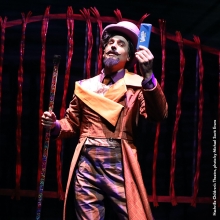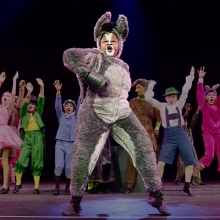Metatheatre in THE DROWSY CHAPERONE and DIRTY ROTTEN SCOUNDRELS
Metatheatre in THE DROWSY CHAPERONE and DIRTY ROTTEN SCOUNDRELS
By Kathryn Harris on August 18, 2009
in
Show/Author Spotlight, Announcements
| Tags:
lambert, lane, martin, mckellar, morrison, yazbek, New Shows, Show Spotlight
Say the term "metatheatre," and most people will think of Bertolt Brecht. Brecht's shows, such as The Threepenny Opera, were groundbreaking for their use of metatheatre to provide social commentary. By having the characters in the play be aware that they're characters in a play, metatheatre distances the audience, making them focus more on the political commentary of a piece than on its characters and plot. Metatheatre has had a strong presence on Broadway in recent years, but for reasons more comedic than political. 2006's THE DROWSY CHAPERONE and 2005's DIRTY ROTTEN SCOUNDRELS don't just use metatheatre for laughs, but to enhance the show's themes. In THE DROWSY CHAPERONE, metatheatre welcomes the audience into the show-within-a-show as a way to connect to the main character. DIRTY ROTTEN SCOUNDRELS, which focuses on con men, uses metatheatre to bring the audience in on the joke.
With a book by Bob Martin and Don McKellar and score by Lisa Lambert and Greg Morrison, THE DROWSY CHAPERONE uses its metatheatrical structure to give the audience a way to connect with the lead. The show centers on an avid musical theatre fan-known only as Man In Chair-as he guides the audience through the record of his favorite show, The Drowsy Chaperone. As the show-within-a show unfolds, Man In Chair periodically interjects with his opinions and background on the actors. Between his passion for the show and his quirky yet matter-of-fact delivery, Man In Chair quickly wins the audience over. His descriptions of what happened to the actors after the show express his particular sense of humor.About one actor, Man In Chair remarks:
“I saw him on the news recently ‘celebrating’ his 100th birthday…They wheeled him out and he had that wide-eyed expression of pained confusion that God reserves for the very, very old on their birthdays.You know, the one that says ‘Who are you, who am I and why is this cake on fire?’”
When Man In Chair shares such trivia, he also gives the audience a better appreciation of the show. Instead of seeing The Drowsy Chaperone as a silly, outdated musical, the audience is able to see the piece in a larger context. By explaining the relationship between two actors or describing common character archetypes of the era, Man In Chair enables the audience to look at the show from multiple perspectives.
Man In Chair also openly admits the show isn’t perfect.“Now, when you’re listening to this, try to ignore the lyrics,” he mentions as a ballad begins.“They’re not the best, but the tune is beautiful.” By voicing his opinion of the song—one that the audience will most likely share—Man In Chair gives the audience permission to laugh at the lyrics, since he thinks they’re funny, too.He further unites himself with the audience with a frustrated yet comical tirade when his ringing phone interrupts the end of a scene:
“Oh, well, that’s it. The moment is ruined. Thank you. Thank you life. It’s like a cell phone going off in a theatre…’Hello? What are you doing?’ ‘Oh, I’m at the theatre ruining the moment. How about you?’ ‘Oh, I just couldn’t get out tonight so I thought I’d ruin the moment by proxy.’”
Here, Man In Chair not only gives the audience an outlet for a common theatergoing annoyance; he also uses the audience as a confidant.
But just as Man In Chair establishes the audience as an equal, he makes it clear that the audience is not exempt from his sarcasm.He doesn’t think twice about letting out a zinger when it’s clear the audience doesn’t know as much as he does. “That was Jane Roberts as the bride,” he points out.“She was the Oops Girl.Remember?Surely you remember the Oops Girl? Don’t you people read?” Through these remarks, Man In Chair realizes that while the audience may enjoy The Drowsy Chaperone as much as he does, his depth of knowledge has an alienating effect.“I love Percy Hyman,” he declares about the lead actor.“Now, some people say he was a bad actor, but to those people I say, ‘Shut up.’” Man In Chair has succeeded in enhancing the audience's enjoyment of the show--but he has difficulty connecting with others on a more personal level.
While seemingly letting the audience in on the joke, Man In Chair actually demonstrates his isolation when he actively shuts down around someone else who loves musicals.“You like musicals?” the super asks.
“No,” answers Man In Chair.
“I love musicals,” the super continues.“I go with the wife all the time.It’s amazing what they can do nowadays—“
"Really. Well, good-bye."
With that, Man In Chair closes the door, resuming his complaints about how the super’s interruption “ruined it…the mood is broken.”Instead of engaging the super in conversation, Man In Chair gets him out of the apartment as quickly as possible so he can go back to the record.
The show ends with all the characters from The Drowsy Chaperone singing small reprises of previous numbers, with Man In Chair climbing into a character’s airplane and flying away—presumably into the show itself.In fully surrendering himself to a harmless 1920s musical comedy like The Drowsy Chaperone, Man In Chair commits to entirely burying himself in artifice at the cost of interpersonal relationships.If Martin and McKellar’s book hadn’t employed metatheatrical techniques, however, the extent to which Man In Chair is a filter for the audience probably wouldn’t have been as evident or as powerful.
DIRTY ROTTEN SCOUNDRELS uses metatheatre to the opposite end. When David Yazbek and Jeffery Lane's musical is self-aware, it's to make the audience a part of the show. Experienced con artist Lawrence Jameson lays the groundwork in the show's opening number. Titled "What They Want," Lawrence uses the song to give the audience instructions in deceit:
"Left hand, side pocket
Right arm, akimbo and relaxed.
Head up, gaze steady,
Now you're ready so you
Stroll in, survey them.
Your world, they're all invited guests
Feel out how to play them,
And remember this-
You're giving them what they want."
The audience knows exactly where it stands as soon as Lawrence begins to
Metatheatre also makes the audience a part of the show by illustrating how pervasive the con is. Lawrence controls elements such as music and lighting by snapping his fingers, talks to the conductor, and even asks if he's missed a scene at one point. An usher sings part of a number about how irresistible Lawrence is. Another character notices when the balcony she's on starts moving, and yet another character shushes another with "Please, the lady is singing." Towards the end of the show, the character who had been conning Lawrence and Freddy all along appears in the pit, conducting the orchestra. The characters' awareness that they're in an artificial environment has two implications. First, it illustrates that the con affects the musical itself, since the characters are able to affect technical elements of the show itself. In "Like Zis/Like Zat," for example, the set and lighting become increasingly romantic according to the characters' wishes. "Like zis-ze moon,/As round as a balloon,/Suspended like a bauble in ze sky," one character sings-and a moon appears before he begins his next line. Giving the characters so much control over their environment in a seduction number shows how good the two are at creating a romantic scene. Likewise, giving Lawrence and Freddy the ability to affect their environment means that they're such clever manipulators that they can even manipulate the show they're in. Second, the characters' awareness they're in a show enables them to bring the audience right into the story. Because the characters frequently break the fourth wall, there's much less of a barrier between the audience and the characters than there otherwise would be, making the audience feel like they're experiencing the events alongside the people onstage. When characters can appear in the audience, it opens up the world of the show, as it's no longer limited to the stage, and the audience is brought right into the action-and the con. Through metatheatre, the audience can feel as though they're directly involved in the story-through the rapport with Lawrence as well as through feeling like part of the con.
Musical theatre is commonly seen as a way to escape into another world. "I didn't pay good money to have the fourth wall come crashing down around my ears," laments THE DROWSY CHAPERONE's Man in Chair. "I just want a story, and a few good songs that will take me away." THE DROWSY CHAPERONE and DIRTY ROTTEN SCOUNDRELS certainly provide the story and the songs, but their metatheatrical nature prevents audiences from only being entertained. In creating relationships between the audience, the show, and himself, Man in Chair causes audience members to look more critically at themselves and their relationship with musical theatre. Do they use musicals-or anything else they're passionate about-to connect with other people? Or, like Man in Chair, do they use theatre to shut people out? Similarly, DIRTY ROTTEN SCOUNDRELS raises questions of the audience's relationship to a performance. If theatre is a con, is it one the actors play on the audience, or is it one the audience is in on? Neither show provides a clear answer. And in the spirit of Brecht, they shouldn't.
For more information and to license THE DROWSY CHAPERONE, check out its MTI show page. For more information and to license DIRTY ROTTEN SCOUNRELS, check out its MTI show page. To share your thoughts on this article or discuss these shows, visit THE DROWSY CHAPERONE's MTI ShowSpace page and DIRTY ROTTEN SCOUNDRELS' MTI ShowSpace page.
With a book by Bob Martin and Don McKellar and score by Lisa Lambert and Greg Morrison, THE DROWSY CHAPERONE uses its metatheatrical structure to give the audience a way to connect with the lead. The show centers on an avid musical theatre fan-known only as Man In Chair-as he guides the audience through the record of his favorite show, The Drowsy Chaperone. As the show-within-a show unfolds, Man In Chair periodically interjects with his opinions and background on the actors. Between his passion for the show and his quirky yet matter-of-fact delivery, Man In Chair quickly wins the audience over. His descriptions of what happened to the actors after the show express his particular sense of humor.About one actor, Man In Chair remarks:
“I saw him on the news recently ‘celebrating’ his 100th birthday…They wheeled him out and he had that wide-eyed expression of pained confusion that God reserves for the very, very old on their birthdays.You know, the one that says ‘Who are you, who am I and why is this cake on fire?’”
When Man In Chair shares such trivia, he also gives the audience a better appreciation of the show. Instead of seeing The Drowsy Chaperone as a silly, outdated musical, the audience is able to see the piece in a larger context. By explaining the relationship between two actors or describing common character archetypes of the era, Man In Chair enables the audience to look at the show from multiple perspectives.
Man In Chair also openly admits the show isn’t perfect.“Now, when you’re listening to this, try to ignore the lyrics,” he mentions as a ballad begins.“They’re not the best, but the tune is beautiful.” By voicing his opinion of the song—one that the audience will most likely share—Man In Chair gives the audience permission to laugh at the lyrics, since he thinks they’re funny, too.He further unites himself with the audience with a frustrated yet comical tirade when his ringing phone interrupts the end of a scene:
“Oh, well, that’s it. The moment is ruined. Thank you. Thank you life. It’s like a cell phone going off in a theatre…’Hello? What are you doing?’ ‘Oh, I’m at the theatre ruining the moment. How about you?’ ‘Oh, I just couldn’t get out tonight so I thought I’d ruin the moment by proxy.’”
Here, Man In Chair not only gives the audience an outlet for a common theatergoing annoyance; he also uses the audience as a confidant.
But just as Man In Chair establishes the audience as an equal, he makes it clear that the audience is not exempt from his sarcasm.He doesn’t think twice about letting out a zinger when it’s clear the audience doesn’t know as much as he does. “That was Jane Roberts as the bride,” he points out.“She was the Oops Girl.Remember?Surely you remember the Oops Girl? Don’t you people read?” Through these remarks, Man In Chair realizes that while the audience may enjoy The Drowsy Chaperone as much as he does, his depth of knowledge has an alienating effect.“I love Percy Hyman,” he declares about the lead actor.“Now, some people say he was a bad actor, but to those people I say, ‘Shut up.’” Man In Chair has succeeded in enhancing the audience's enjoyment of the show--but he has difficulty connecting with others on a more personal level.
While seemingly letting the audience in on the joke, Man In Chair actually demonstrates his isolation when he actively shuts down around someone else who loves musicals.“You like musicals?” the super asks.
“No,” answers Man In Chair.
“I love musicals,” the super continues.“I go with the wife all the time.It’s amazing what they can do nowadays—“
"Really. Well, good-bye."
With that, Man In Chair closes the door, resuming his complaints about how the super’s interruption “ruined it…the mood is broken.”Instead of engaging the super in conversation, Man In Chair gets him out of the apartment as quickly as possible so he can go back to the record.
The show ends with all the characters from The Drowsy Chaperone singing small reprises of previous numbers, with Man In Chair climbing into a character’s airplane and flying away—presumably into the show itself.In fully surrendering himself to a harmless 1920s musical comedy like The Drowsy Chaperone, Man In Chair commits to entirely burying himself in artifice at the cost of interpersonal relationships.If Martin and McKellar’s book hadn’t employed metatheatrical techniques, however, the extent to which Man In Chair is a filter for the audience probably wouldn’t have been as evident or as powerful.
DIRTY ROTTEN SCOUNDRELS uses metatheatre to the opposite end. When David Yazbek and Jeffery Lane's musical is self-aware, it's to make the audience a part of the show. Experienced con artist Lawrence Jameson lays the groundwork in the show's opening number. Titled "What They Want," Lawrence uses the song to give the audience instructions in deceit:
"Left hand, side pocket
Right arm, akimbo and relaxed.
Head up, gaze steady,
Now you're ready so you
Stroll in, survey them.
Your world, they're all invited guests
Feel out how to play them,
And remember this-
You're giving them what they want."
The audience knows exactly where it stands as soon as Lawrence begins to
Metatheatre also makes the audience a part of the show by illustrating how pervasive the con is. Lawrence controls elements such as music and lighting by snapping his fingers, talks to the conductor, and even asks if he's missed a scene at one point. An usher sings part of a number about how irresistible Lawrence is. Another character notices when the balcony she's on starts moving, and yet another character shushes another with "Please, the lady is singing." Towards the end of the show, the character who had been conning Lawrence and Freddy all along appears in the pit, conducting the orchestra. The characters' awareness that they're in an artificial environment has two implications. First, it illustrates that the con affects the musical itself, since the characters are able to affect technical elements of the show itself. In "Like Zis/Like Zat," for example, the set and lighting become increasingly romantic according to the characters' wishes. "Like zis-ze moon,/As round as a balloon,/Suspended like a bauble in ze sky," one character sings-and a moon appears before he begins his next line. Giving the characters so much control over their environment in a seduction number shows how good the two are at creating a romantic scene. Likewise, giving Lawrence and Freddy the ability to affect their environment means that they're such clever manipulators that they can even manipulate the show they're in. Second, the characters' awareness they're in a show enables them to bring the audience right into the story. Because the characters frequently break the fourth wall, there's much less of a barrier between the audience and the characters than there otherwise would be, making the audience feel like they're experiencing the events alongside the people onstage. When characters can appear in the audience, it opens up the world of the show, as it's no longer limited to the stage, and the audience is brought right into the action-and the con. Through metatheatre, the audience can feel as though they're directly involved in the story-through the rapport with Lawrence as well as through feeling like part of the con.
Musical theatre is commonly seen as a way to escape into another world. "I didn't pay good money to have the fourth wall come crashing down around my ears," laments THE DROWSY CHAPERONE's Man in Chair. "I just want a story, and a few good songs that will take me away." THE DROWSY CHAPERONE and DIRTY ROTTEN SCOUNDRELS certainly provide the story and the songs, but their metatheatrical nature prevents audiences from only being entertained. In creating relationships between the audience, the show, and himself, Man in Chair causes audience members to look more critically at themselves and their relationship with musical theatre. Do they use musicals-or anything else they're passionate about-to connect with other people? Or, like Man in Chair, do they use theatre to shut people out? Similarly, DIRTY ROTTEN SCOUNDRELS raises questions of the audience's relationship to a performance. If theatre is a con, is it one the actors play on the audience, or is it one the audience is in on? Neither show provides a clear answer. And in the spirit of Brecht, they shouldn't.
For more information and to license THE DROWSY CHAPERONE, check out its MTI show page. For more information and to license DIRTY ROTTEN SCOUNRELS, check out its MTI show page. To share your thoughts on this article or discuss these shows, visit THE DROWSY CHAPERONE's MTI ShowSpace page and DIRTY ROTTEN SCOUNDRELS' MTI ShowSpace page.



























